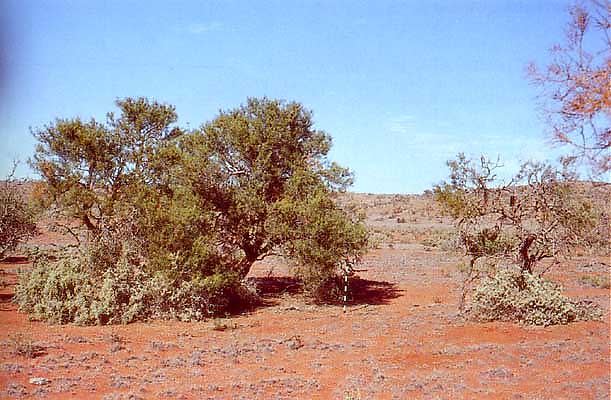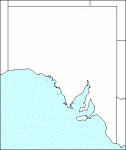Family: Fabaceae
Acacia carnei

Citation:
J. H. Maiden, J. Proc. R. Soc. N.S.W. 49:470 (1916).
Derivation: carnei—in honour of Joseph Edmund Carne (1855-1922) Govt. Geologist of New South Wales and his son Walter Mervyn Carne a botanical assistant to J. H. Maiden.
Synonymy: Not Applicable Common name: needle wattle, dead finish
Description:
Tall, rigid, dark green, straggly, spreading, prickly (due to the pungent phyllodes) shrubs or small trees with a single main trunk or branching into a few main stems at ground level and developing a dense crown with intricate branches; branchlets almost terete, covered with fine soft whitish pubescence; older branches mid-dark grey, becoming almost glabrous, trunk greyish with a rough stringy fissured bark; spreading by suckering.
Phyllodes linear-subulate, tetragonous when dry, 2-6.5 cm long, 1-2 mm diam., very rigid, erect spreading to (horizontal), straight or slightly curved with fine whitish hairs thinly scattered over the surface when mature; veined at each angle, with rounded ridges at the angles and shallow grooves in between, apex somewhat abruptly tapering into a rigid reddish-brown pungent point. Glands small orbicular near the base.
Inflorescences simple and axillary, solitary, rarely twin; flower-heads globular, bright yellow, 45-50-flowered; peduncles very sparse, 12-25 mm long, greenish at first but becoming reddish-brown when dry; flowers 5-merous. Legumes rarely produced, oblong 3-5 cm long c. 10 mm broad, thickly coriaceous. Seeds longitudinal in legume, ovoid; funicle short, abruptly thickened into a large yellowish aril.
|
|
Distribution:
|
Eastern region from near Frome Downs, Koonamore, eastward to Plumbago and Boolcoomata across the border into western N.S.W., in low shrubland associated with Maireana pyramidata, Atriplex vesicaria and Rhagodia spinescens. South of Cockburn to Mutooroo along the N.S.W. border associated with Callitris preissii on low spreading sand ridges. A specimen was collected from one isolated tree near Peterborough in 1961. Soils; shallow calcareous loamy, brown calcareous earths, crusty alkaline and neutral red duplex. Rainfall 200 mm.
|
Conservation status:
Lung & Kraehenbuehl (1987) consider this species Uncommon to Endangered and Briggs & Leigh (1988) to be Rare.
Flowering time: Irregular periods throughout the year.
|

SA Distribution Map based
on current data relating to
specimens held in the
State Herbarium of South Australia
|
Biology:
No text
Taxonomic notes:
Whibley (1979) describes the history of the collections of A. carnei in South Australia and the account of a trip made in 1978 to the major sites in the east of the State. He states that it is readily mistaken for a Hakea in the field. It seems to occur in colonies of 20-60 plants which are clonal (i.e. develop from suckers) though it would obviously depend on the season, flowers were never common and fruits were rare.
A single collection of A. carnei from Ooldea is in the State Herbarium, collected by T. G. B. Osborn in August 1922. It has never been relocated although the area about Ooldea was well collected by E. Ising. T. G. B. Osborn also collected A. carnei at Koonamore and it is likely that some muddling of labels has occurred.
Cultivation:
Not known in cultivation.
Author:
Not yet available
Source:

|

